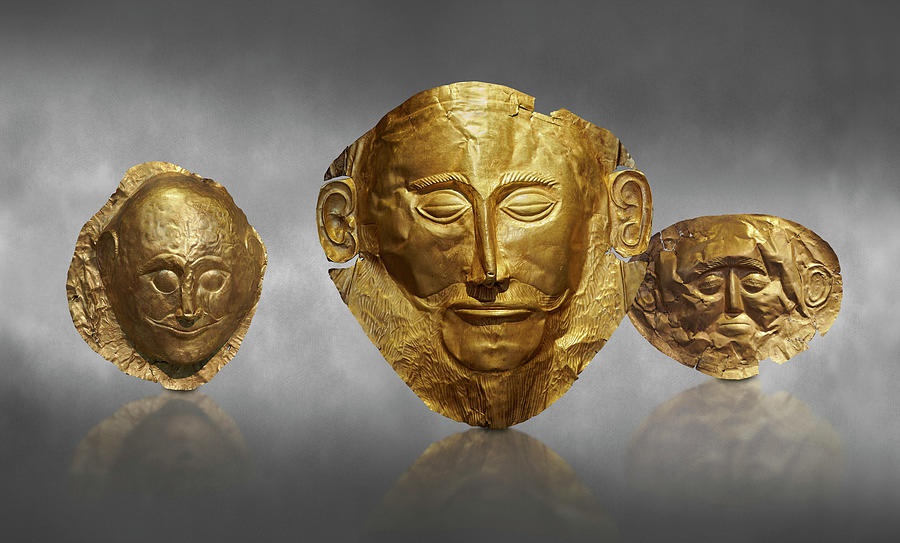The “Mask of Agamemnon” stands as one of the most iconic artifacts from the Greek Bronze Age. Discovered in 1876 at Mycenae by the renowned archaeologist Heinrich Schliemann, this gold funeral mask was one of several found over the faces of the deceased in the royal shaft graves. The most detailed and distinctive among these masks was named after Agamemnon, the legendary king of Mycenae celebrated in Homer’s epics and Euripides’ tragedies. The Metropolitan Museum of Art houses an electrotype reproduction of this mask, created by Emile Gilliéron père around 1906. This replica, made using an electroforming technique, provides a fascinating glimpse into both ancient craftsmanship and early 20th-century reproduction methods.
The Significance of the “Mask of Agamemnon”

The original “Mask of Agamemnon” is more than just a piece of funerary art; it is a symbol of the grandeur and sophistication of Mycenaean civilization. Crafted from a single sheet of gold, the mask exemplifies the advanced metallurgical skills of the ancient Greeks. The Metropolitan Museum’s electrotype reproduction, although made from different materials and methods, allows modern viewers to appreciate the intricate details and historical significance of the original artifact.
Electrotype Technique: A 19th-Century Innovation
The electrotype technique, developed in the 19th century, revolutionized the reproduction of historic metalworks. Before the advent of color photography and widespread travel, electrotype reproductions served as vital tools for disseminating knowledge about ancient cultures. These replicas were considered precise, despite differences in materials and manufacturing processes from the originals. The electrotype of the “Mask of Agamemnon” is a prime example, offering a faithful representation of the original’s form and aesthetic.
Creating the Replica: The Process of Electroforming

Molding the Original
To create an electrotype, a mold of the original object’s surface is essential. In the case of the “Mask of Agamemnon,” the mold captured the front surface’s fine details. The material used for molding had to be separable from the original artwork while preserving its intricate details and withstand immersion in an electroplating solution. Common materials included plaster, sulfur, stearin, wax, gelatin, and gutta-percha, the latter derived from the latex sap of the Palaquium tree. While Gilliéron’s exact methods remain unknown, gutta-percha was often favored for its excellent results.
Electroplating the Mold
Once the mold was prepared, it was coated with a conductive material like graphite, allowing it to act as an electrode in an electroplating bath. Copper or another base metal was then plated onto the mold’s surface. For the “Mask of Agamemnon” replica, copper was used. When the copper layer was sufficiently thick, the electroform was removed from the mold. The front of the copper replica was smooth, preserving the original’s surface features, while the back had an irregular texture due to the electroforming process.
Gilding the Electroform
The final step involved gilding the copper replica with a layer of gold. Analysis using X-ray fluorescence spectrometry (XRF) revealed traces of mercury on the Metropolitan Museum’s replica, suggesting the use of mercury as a quicking agent to facilitate gold adhesion. This method reflects both ancient fire gilding techniques and modern electroforming practices.
Comparing the Replica and the Original

Radiographic images highlight the differences between the original gold mask and the electrotype replica. The original mask, likely raised from a single gold sheet, shows a hammered texture, while the electrotype exhibits the characteristic texture of the electroforming process. These differences underscore the distinct methodologies and materials used in ancient and modern craftsmanship.
The Role of Electrotypes in Museums
Electrotypes played a crucial role in museum collections and public education during the late 19th and early 20th centuries. They allowed museums to display accurate replicas of significant artworks, making cultural heritage accessible to a broader audience. Today, the Gilliéron electrotypes at the Metropolitan Museum remind us of the institution’s early collecting practices and the historical importance of replicas in art conservation and education.
Conclusion
The electrotype reproduction of the “Mask of Agamemnon” by Emile Gilliéron père exemplifies the intersection of ancient artistry and modern reproduction techniques. While differing in materials and methods, the replica offers a vivid impression of the original artifact’s form and detail. As we continue to study and display such reproductions, they provide invaluable insights into both the past and the evolution of museum practices. The “Mask of Agamemnon” replica, along with other electrotypes, remains a testament to the enduring legacy of Mycenaean civilization and the innovative spirit of early 20th-century art reproduction.
